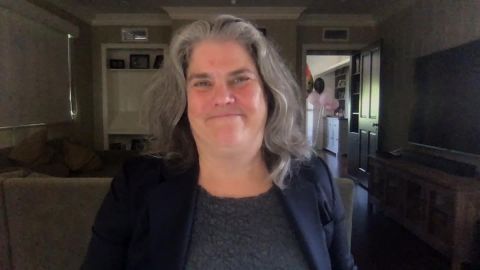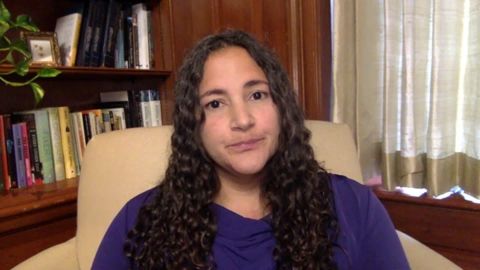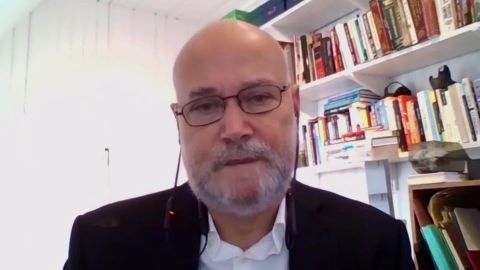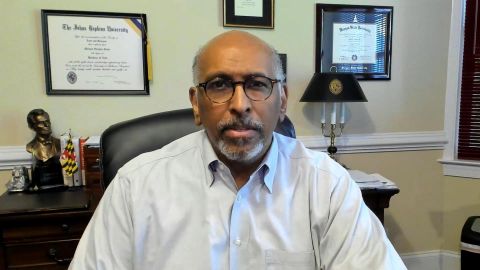Read Transcript EXPAND
CHRISTIANE AMANPOUR: Now, mail-in voting has been tried and tested as part of America’s electoral system for decades. Yet, in recent months, it’s been the target of a — quote — “coordinated disinformation campaign propagated not by Russia, but by the president of the United States and his Republican allies,” this from a new Harvard University report, which studied how President Trump is using both traditional and social media to create a fake story about mail-in voting. Yochai Benkler has led the study. And he is the Berkman professor of entrepreneurial legal studies at Harvard Law School. And here he is talking to our Hari Sreenivasan about the report.
HARI SREENIVASAN: Christiane, thanks. Professor Benkler, thanks so much for joining us. What were your findings when you looked at all the data, when you looked at this as a campaign? What did you find?
YOCHAI BENKLER, HARVARD LAW SCHOOL: We analyzed tens of thousands of stories, tens of thousands of Facebook posts, millions of tweets. And, repeatedly, what we found was that whenever there was a spike in attention to voter fraud, every few weeks, the precipitating event was almost always a statement by President Trump, sometimes on TV interviews on FOX, sometimes in the press briefings, and often on Twitter, and that these were closely related with statements by the RNC, with lawsuits brought by state Republican committees, and that this action by political elites, essentially the president and his party, were what drove the coverage, whereas social media coverage was really quite secondary. It just took what was already out there and recirculated it. So, this made us think that the basic model we have, where you have these distributed Facebook trolls or Russians, just isn’t what’s operating on this campaign, and it’s not what’s important for the most important disinformation campaign of the 2020 election.
SREENIVASAN: When you talk about the president making statements. I mean, he was making statements about voter fraud after he won the election in 2016, set up a commission to study it. So what was so different this summer?
BENKLER: We saw a significant spike in the number of times and the set-off events that started right after the signing of the first coronavirus stimulus bill, and which included mail-in ballots. So, you see a level of reference to voter fraud. And then, suddenly, beginning in early April, it becomes a major issue. And one of the things you see in the paper, when you look at the data, is that the attention to the topic becomes much larger, the number of statements is high, and the set of actions associated with them is also high. And you just look one issue after the other, one spike after the other, and you see a tremendous change. And, in truth, the president responds to the stimulus bill by saying, Democrats want this; if they get what they want, Republicans will never be elected again. And right after that, you begin to see a series of waves of attention driven primarily by statements of political elites recirculated on FOX, on talk radio, on right-wing media, and obviously grabbing the attention of major mainstream professional journalists, because the president is saying it. And what the president is saying is often intentionally outrageous and norms-breaking in a way that forces itself into the headlines.
SREENIVASAN: So, give me an example for people who don’t study media. How does — how is that frame set? Is it about the way that the headline is written? Is it about the way that the reporter is asking for a comment?
BENKLER: Exactly. So, let me just give you one example. On May 1, the president tweets out a study that comes out of a conservative think tank, saying that 28 million ballots have disappeared between 2012 and 2018, a very specific statement. The day after, ProPublica comes out with a fact-check and says, this is bunk. But a couple of days later, the Associated Press comes out with a story of partisan bickering over mail-in voter fraud, where the lead says mail-in voting in the pandemic leads to partisan — to disinformation social media. But it’s not social media. It’s actually the president. So that’s the kind of thing that happens. You have a headline that says mail-in voters in some neutral — mail-in voting in some neutral sense is contested. You have a lead that says, Republicans or the president said this, Democrats have long claimed that. And then in the next paragraph, it says there has been no — historically, there’s been no evidence of voter fraud. By contrast, by August, we saw more statements where the same — the AP again will come back and say, on Thursday, the president continued his unsubstantiated claims aimed to undermine mail-in voting or some — that wasn’t quite as extreme as that, but will use much more of the techniques we know are important when dealing with propaganda or disinformation or even just fake news, which is, right up front, calling them unsubstantiated claims, calling them false, in order to make it easy for readers to understand that these are not normal statements, that these are not acceptable statements.
SREENIVASAN: You mentioned the Associated Press. And most people are unaware of how the wire service works, how syndication works. What was the role there, when the AP puts out a story, and it shows up where? In lots of local papers, local TV sites?
BENKLER: Yes. So, this was, again, one of those things where the nice things when you work with data is it sometimes teaches you something new. And as we looked at each of these peaks, suddenly, it turned out that a lot of the peaks in the stories that were associated also with the peaks in everything else, in Facebook and Twitter, a lot were just the same story over and over again duplicated on local TV stations, on city papers, on regional news sites. And so, when we analyzed it with text analysis, it became very clear that there were these communities of sites that were using syndication, most important in this regard, really, AP, local TV, online stations, also included a variety of stories from CNN and other stories. But, again, these are syndicated duplicated stories. And what’s really important about this is that the — when we look at survey evidence, not from our research, but, say, Pew, on where people say they get their news, there’s a large segment of the American population that gets its news from local TV, from the traditional broadcast networks, ABC, CBS, and NBC. And, interestingly, it’s these people — and more people say that that’s where they get their news, their primary source of news, than people who say from all social media put together. And what’s interesting about the demographics of those people is that they are the least politically pre-committed. They’re not watching FOX News or MSNBC all day. They’re not interested in the 24-hour news cycle. They want to get a little bit of news, if that. And they’re really focused on these sites that we pay almost no attention to. And those are the persuadables, right? The people who really might still change their minds about whether the election was legitimate or not, about whether it’s safe to vote by mail or not, these are the people who are not paying so much attention. And what the survey evidence tells us is that they’re also the ones who are most confused about whether mail-in voting really does or doesn’t involve a lot of fraud. And so it’s those outlets and those professional journalism who reach out to these people in the places where they are, in the local TV that they say always in surveys they trust the most, they’re the ones who can help people say, no, actually, there’s no evidence that there’s voter fraud.
SREENIVASAN: What role do Facebook and Twitter have in trying to tamp down this sort of disinformation?
BENKLER: So, I think, first of all, remember, our study is focused on this one major issue. It’s focused on this issue because we think it’s important. We’re not saying there aren’t narrower, more discreet disinformation or — campaigns or just fake news, false nonsense, circulating on social media. The implication is not social media doesn’t matter at all or they should stop trying to stop nonsense. The implication is much more specific, which is that on this, the most important issue, that’s not where things came. At the same time, the study we did here also fits what we saw in the 2016 election and the first year of the Trump presidency, which is work we have done in the past and published on, which is that Facebook and Twitter capture our imagination, because we’re at a moment at which we imagine that technology is changing everything, but it turns out society is more complex. There are multiple scientific studies in the — from the last three years who look specifically at fake news. And, repeatedly, what they find is that the people who are most exposed to the kind of fake news we think about, really completely fake sites, circulating on Facebook or being tweeted out by trolls, are a tiny proportion of the population, overwhelmingly represented by over 65-year-old, primarily conservatives. So, you have got a narrow segment of people who are already persuaded of a certain viewpoint looking for stories to feed their outrage. That’s the model. But if you’re actually trying to see what shapes the views of tens of millions of Americans, it turns out to be less about Facebook and Twitter, and more about a combination of the 24-hour news channels, the broadcast networks, local TV, radio. These turn out to still be much more important than we give them credit when we think about the media ecosystem.
SREENIVASAN: So, what does a local TV news station do or what should they do? Or what does a headline writer at the Associated Press do? How do the press stop contributing to the disinformation campaign?
BENKLER: I think what a headline writer needs to do is overcome deeply entrenched professional commitment to appear balanced and do the fact- checking first and the headline-writing later. Today, mostly, what we have are headlines that are neutral to make sure the media outlet, the local television station doesn’t — it doesn’t appear to be taken a side. And then, at most, you have a fact-checking column or a fact-checking section separately. Instead, you need to say, is this true, is this false? If it’s false, the headline itself needs to be saying, in this case, something like, President Trump once again trumps the false claims — or trumpets the false claims of mail-in voter fraud, or, without basis, or, unsubstantiated claims, right in the headline. Then the lead needs to be again, on Tuesday, the president repeated unsubstantiated claims that he had been trying to make against voter fraud since the spring, so that, as the audience first encounters the news that the president has said this, or the RNC has issued a statement at that, that that’s a statement that is inconsistent with the consensus research view of what actually has happened. And the method we see repeated again and again is that a story happens. Now, it’s a real story. They’re not made-up stories. Some stories are made up. But, sometimes, there’s a real story. A mail carrier in West Virginia changes a few mail-in ballot requests for the primaries from Democrat to Republican, and then he’s interviewed and said, himself, he thought it was funny. What happens is, that becomes evidence, and it gets picked up by the right- wing media ecosystem, sometimes by FOX, sometimes by online sites like Breitbart, sometimes by “The New York Post” or RealClearPolitics, and gets reported. And when you listen to the president, often, he will string together a set of such anecdotes from Paterson, New Jersey, West Virginia, Detroit. The core of the story is often true, but the significance is massively inflated. So that requires real education of the audience about the difference between, here, let me tell you a story, which is very powerful, and the actual statistical evidence, which is much harder for people to understand, and so requires careful attention and careful explanation to say, look, yes, there’s a story here, there’s a story there, but if you look at the overall picture, it’s barely a handful of votes over years, over hundreds of millions of votes cast over years. And that needs to be said right out there, because anecdotes are very powerful and very vivid. And statistics are sometimes very difficult for people to understand. But when you look at voting of hundreds of millions of people, the anecdotes don’t matter. They’re a sideshow.
SREENIVASAN: You’re also asking for news to change its way of operation, especially in the context of what is considered breaking, right, to take more caution about that headline, to take more caution about that lead paragraph, especially in a culture where we think, oh, my gosh, I have to publish this right away to be either first or most relevant or win the social media algorithm game.
BENKLER: I don’t think there’s a choice. I think the reality and recognizing the reality that, if you don’t discipline yourself, as a professional journalist, to take the time to be a little more careful, you become complicit in a disinformation campaign that could disenfranchise millions, and, at least as dangerous, severely damage the perception of legitimacy of the outcome in the eyes of tens of millions of Americans. And if you become the instrument of propaganda, if you become the instrument of disinformation by being careless, how are you fulfilling your goal as the fourth estate? If your goal at the end of the state — yes, of course, in the day to day, you’re trying to get the headline, you’re trying to be relevant, you’re trying to be there ahead. But if you’re faced with evidence that, in effect, these practices are making you complicit in a disinformation campaign, then I think it really is a matter of professional responsibility for journalists to stop and say, take the next 15 minutes. It’s not take five hours. Take the next 15 minutes, be really careful about how true this is, or how much this is part of the disinformation campaign. Get used to shaping things that are part of the disinformation campaign so that you already have the habit of, how do you write such a headline? How do you write such a lead? How do you speak it? And learn how to do that. Otherwise, you really do become an instrument of a campaign that could undermine participation and could undermine the legitimacy of the election.
SREENIVASAN: Yochai Benkler from the Berkman Klein Center For Internet & Society at Harvard University, thanks so much for joining us.
BENKLER: Pleasure to be with you.
About This Episode EXPAND
Michael Steele; Laurie Santos; Yochai Benkler; Andrea Ghez
LEARN MORE



